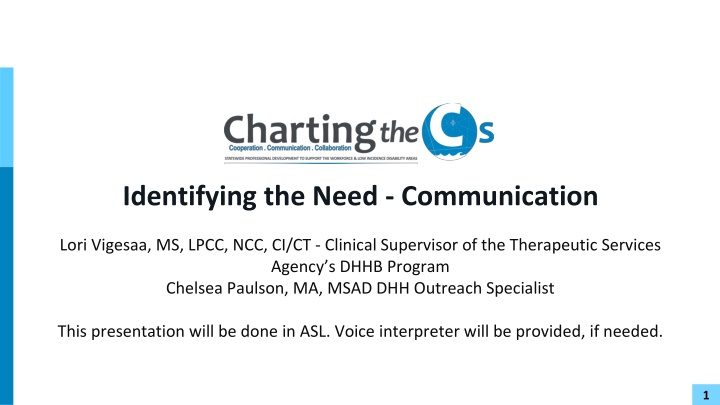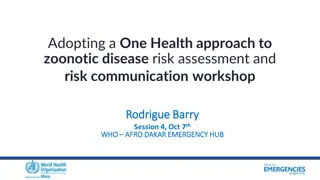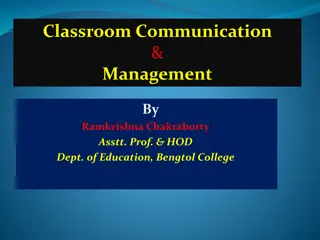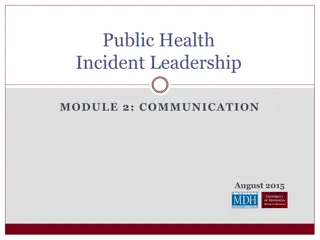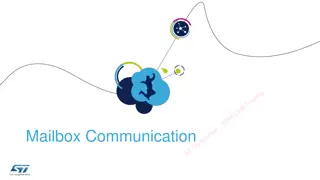Identifying the Need - Communication
This presentation explores the impact of communication in developmental disorders, covering topics such as normal development factors, birth diagnosis implications, neural and cognitive development, emotional and behavioral impacts, and the role of language in delay theory. Attendees will gain valuable insights into recognizing and addressing communication needs in individuals with developmental challenges.
Download Presentation

Please find below an Image/Link to download the presentation.
The content on the website is provided AS IS for your information and personal use only. It may not be sold, licensed, or shared on other websites without obtaining consent from the author.If you encounter any issues during the download, it is possible that the publisher has removed the file from their server.
You are allowed to download the files provided on this website for personal or commercial use, subject to the condition that they are used lawfully. All files are the property of their respective owners.
The content on the website is provided AS IS for your information and personal use only. It may not be sold, licensed, or shared on other websites without obtaining consent from the author.
E N D
Presentation Transcript
Identifying the Need - Communication Lori Vigesaa, MS, LPCC, NCC, CI/CT - Clinical Supervisor of the Therapeutic Services Agency s DHHB Program Chelsea Paulson, MA, MSAD DHH Outreach Specialist This presentation will be done in ASL. Voice interpreter will be provided, if needed. 1
Agenda For ASL CEUs, we acknowledge that this is a meaty content - so we ask you to ask us if you need repeat, or clarification on sign choices. We will be covering these topics in ASL: What is Normal Development Verbal/Signed Communication Nonverbal Communication Questions to Ask Yourselves as a Professional We are providing the content in Deaf Culture to count toward ASL CEUs. 2
What is Normal Development? Five factors of a normal development: Physical Neural Cognitive Emotional Behavioral 3
Diagnosis at Birth Impacts of illnesses, syndromes, and other congenital deficits Be aware and watchful at major developmental stages Ex: Congenital Cytomegalovirus (CMV) - can present as ADHD, but it is not 4
Diagnosis at Birth, continued Trauma In utero can impact Cortisol is released when the mother is under extreme stress Has been found to impact the developing amygdala in biologically female babies Heightened stress reactivity, negative emotionality, and higher levels of internalizing symptoms. Link to neurodevelopmental and psychiatric disorders in children 5
Neural, Cognitive, Emotional, and Behavioral Development All of these tend to develop at the same time throughout the lifespan They are all impacted and throw off typical developmental trajectory by: Trauma Experienced before the age of three can cause problems in relationship/bonding with parents and others, foundational development in language, mobility/physical/social skills, and emotional regulation. 6
Neural, Cognitive, Emotional, and Behavioral Development, continued Language Deprivation Delays Theory of Mind development Toxic Stress can lead to PTSD symptoms You can have someone with high cognitive abilities, but their perceptions and/or reasoning can be distorted. Significant disruption in the family Trauma ACEs (5+) Theory of Mind 7
Questions to Ask Yourself As A Professional Is Emotional and/or Behavioral Dysregulation intrusive to academics and/or relationships? Are you seeing/hearing negative self-concept statements theory of mind development is delayed increase in worries/fears Refusals and/or consistent irritability Withdrawal and/or isolation from school, activities, or others Academic decline 8
Questions to Ask Yourself As A Professional, continued Do you know if there is past or recent trauma and Client is struggling emotionally, behaviorally, or academically Engaging in risky behaviors Has anger outbursts 9
Thank you! Chelsea Paulson - chelsea.paulson@msa.state.mn.us Lori Vigesaa - lvigesaa@tsapc.net 10
